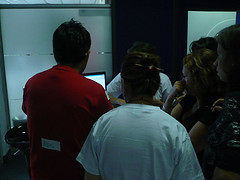http://www.slideshare.net/sleslie/becoming-a-network-learner-presentation
Last week it was my immense honor and privilege to speak with 3 groups of post-secondary educators in Colombia as part of their educamp sessions. Diego Leal invited me to come and do something on “personal learning environments” based on the workshop I had just co-lead a few weeks previously in Phoenix.
The result was this talk (I think there is video of the last version I gave which I will link to when I get it) in which I tried as best I could to capture some of my own struggle to accept that the future is no longer best understood by looking to the past, and my own take on how my relationships with people (and the context we share) informs how I learn with and from them in various tools that make up my PLE.
 But, in the spirit of a ‘camp,’ this was not a one-way exchange (hindered though I was by my absolute lack of Spanish, something I very much regret.) I truly learned much from the experience, both about the amazing country of Colombia, but also about how we should be running professional development workshops. The educamps were very inspiring. Every attention to detail had been paid to create the enabling conditions for learner-supported and learner-directed learning to occur.
But, in the spirit of a ‘camp,’ this was not a one-way exchange (hindered though I was by my absolute lack of Spanish, something I very much regret.) I truly learned much from the experience, both about the amazing country of Colombia, but also about how we should be running professional development workshops. The educamps were very inspiring. Every attention to detail had been paid to create the enabling conditions for learner-supported and learner-directed learning to occur.
Each of the three sessions I attended were held in a Conference Centre, and as I understood it, this was both to provide a space with a reliable simulatenous internet connection for sometimes over 100 people, but also to find a space large enough for their camp model.
You see, in these educamps, space design was an integral part. The Ministry of Education (and Cintel, their partner in delivering these camps) had gone to the trouble of purchasing very comfortable (and stylish, I might add) furniture that was trucked

around to each event. This might seem like an indulgence until you experienced how this created an informal room setup, allowing learners to sit near each other, easily form small groups, and move around the room, leading to the kind of self-organizing behaviour one expects in a ‘camp’ session.
Similarly, throughout most of the day, there was a soundsystem playing music in the background. This was not simply ‘filler’ though the presence of background music certainly added to the sense of informality and helped people relax. Instead, the music actually became a ‘cue’ to help prompt people in not too directive a way to consider moving along; every so often the volume level of the music would go up, and over time people started to use this as the cue to perhaps look for a new conversation.
There were many other seemingly “small” details which I think had a profoundly positive impact on the experience for these learners. All learners received a white ‘camp’ shirt at the start, creating a bit of an equal playing field. One of the first acitivites was asking the participants to ‘tag’ themselves with which of the classes of t ools (they did not focus on single specific tools but instead general classes, like ‘Readers’ or ‘social bookmarking tools’) with which they had experience. In doing this, partly they were making a promise to other learners that if someone came up and asked them about one of their tags, they would talk to them about it.
ools (they did not focus on single specific tools but instead general classes, like ‘Readers’ or ‘social bookmarking tools’) with which they had experience. In doing this, partly they were making a promise to other learners that if someone came up and asked them about one of their tags, they would talk to them about it.
The morning was then given over to the learners exploring (along with some ‘expert’ help, students with some more experience with specific tools, all wearing red shirts) specific tools or groups of tools that they themselves identified as being of interest to them. The idea was not to master the entire array of technologies (there being at least 12 classes of tools that had been identified) nor master them in any prescribed way or order, but instead to explore ones own need in a hands on way, side-by-side with other learners. It is difficult to describe, but I have NEVER seen this kind of buzz or energy happen in ANY of the dozens of North American “pro D” workshops I have led or been subjected to. Indeed, as I told my hosts, I think the great testament to the success of these events is that, despite the fact that they were already scheduled to run from 8am until 5:30pm, we had to kick people out at 5:30!
You can see more photos from the workshop in this flickr collection. They are not great photos, and to some they might look simply like masses of people milling about. To me, they look like masses of people learning together, from each other and not simply mastering prescribed material but actually forming social networks at the same time as they are learning what they wanted and needed to learn. This was a model which truly understood that while studying may be boring, Learning can be fun (and always personal!) A model I hope I can learn to replicate in the years to come. So thank you, Diego, for letting me experience this, it truly was a great learning experience for me. – SWL
